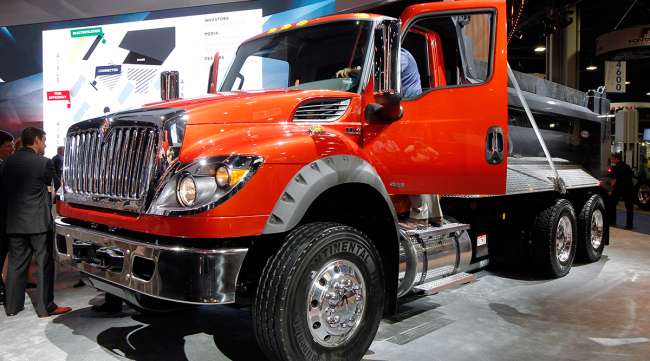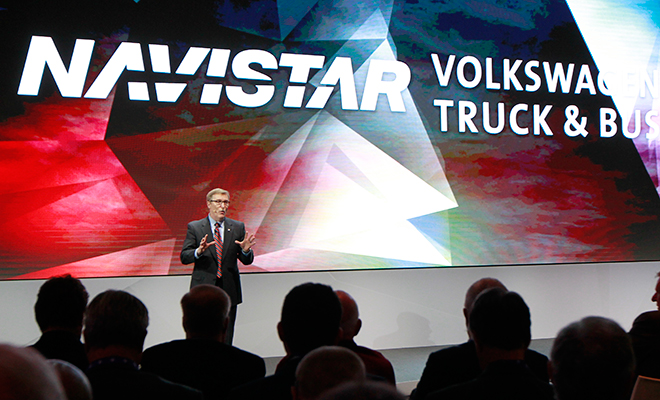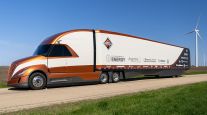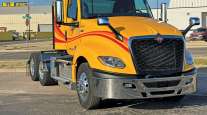Senior Reporter
Navistar Announces New HV Severe Service Model

ATLANTA — Navistar International Corp., the parent company of International Truck, announced its new HV model intended for severe service applications in North America.
At the same, Navistar’s collaboration is accelerating with Volkswagen Bus & Truck, a unit of Volkswagen AG, with whom it forged an alliance in 2016, it said.
The HV will be available with Navistar’s new 12.4 liter engine, the A26, which uses the MAN D26 crankcase, according to Navistar. MAN is a unit of Volkswagen Bus & Truck.
“It’s all about [putting the] driver first. We designed this truck from the inside out imagining a space for drivers who operate these kinds of trucks,” said Denny Mooney, senior vice president of global product development. “Also, it is designed for easy body mounting [to accommodate various applications].”
NACV COVERAGE: All stories | Live blog | Photo gallery
The company made its announcements at the inaugural North American Commercial Vehicle Show here Sept. 25.
Meanwhile, the two truck makers agreed to collaborate on a fully integrated next generation “big bore” powertrain for Navistar, Navistar Chairman and CEO Troy Clarke said. “We believe a proprietary powertrain is important for Navistar, for dealers and, most importantly, for our customers.”
Clarke declined to reveal details of the powertrain intended for North American customers at this time, citing competitive reasons.
“It is set to launch as early as 2021,” he said, which is also when the first of three planned increases in greenhouse gas Phase 2 emissions requirements kicks in for medium- and heavy-duty trucks. The other two timetables are 2024 and 2027.
Also, Navistar and Volkswagen Truck & Bus intend to converge their separate connectivity activities — Navistar’s OnCommand Connection and Volkswagen’s RIO — to a Volkswagen Truck & Bus “global connected vehicle platform,” according to Navistar.
The initial step will be the adoption of common, in-cab connecting device hardware for a network with roughly 650,000 vehicles worldwide — of which, 350,000 are in the U.S. — thereby “making it the world’s largest global ecosystem for commercial vehicles, once the migration is completed,” Clarke said.
Volkswagen Truck & Bus expects to launch the cloud-based, brand-independent platform by the end of the year, according to Navistar.

Clarke by John Sommers II for Transport Topics
“We don’t view it as there is a European cloud and a North American cloud. There is just a cloud and it is around the world,” Clarke said. “No matter where trucks are being run, there is a protocol so they can reach up and pull that data to drive their business systems.”

Renschler by John Sommers II for TT
Asked if the alliance was unfolding at the pace he expected, Andreas Renschler, head of VW’s global Truck & Bus division, said, “From my experience, it is much faster than I thought.”
Clarke added: “I would have thought that we would still be grappling with a handful of issues around technical specs and stuff related to engines. I’m telling you, we got through that kind of stuff really quick. Or can we put together these two purchasing processes? That stuff was through in weeks. I didn’t think we’d be talking about electric trucks or merging our digitalization strategies, but it makes a lot of sense.”
The alliance was completed in March.
In the meantime, Navistar’s existing OnCommand Connection telematics product will be updated to include live action plans that predict when a part is going to fail before it actually does. The telematics system will then alert customers about the potential repair, the parts needed for the repair and the training needed for the repair, according to the company. The feature will be available in 2018.
Also, the companies’ procurement joint venture based in Lisle, Ill., — Global Truck & Bus Procurement — has met with more than 250 new and existing suppliers, and completed 40 joint bidding contracts, according to Navistar.
Navistar also said two-truck platooning using its vehicles, in cooperation with applications developer Peloton Technology, will be available in 2018, too.
Plus, Navistar announced it will launch Classes 6-7 trucks with an electric powertrain in late 2019 or early 2020, given the trucks’ abundance of packaging space, and that they typically run short distances and can recharge at the end of the day.
“Currently, the Cummins ISB engine is the mainstay of our medium-duty product. We don’t offer a different engine. It performs great. It has a great product following,” Clarke said.
Also, Navistar has added updates to its HX series vocational trucks, including offering 51-inch sleepers in the 550 and 650 models, beginning in October. These two HX models also will be available with the A26 engine, starting in May 2018, according to the company.




